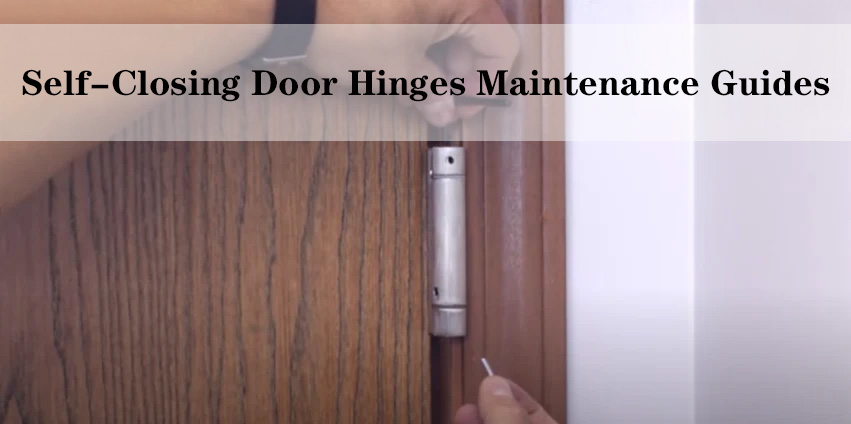(Notes: Continue to post from the Common Problems of Heavy Duty Hinges and How to Fix Them: Part 1)
Problem 6: Door Won’t Stay Open or Closed
Dealing with a door that refuses to cooperate – one that either won’t stay open or won’t stay closed – can be quite frustrating. This issue can disrupt the flow of your space and compromise the functionality of the door.
Solution: Adjusting Hinge Tension
Restoring proper tension in the hinges can often remedy this problem. Here’s a step-by-step guide to help you get your door to stay where you want it:
Identify the Issue: Determine whether the door won’t stay open or won’t stay closed. This will guide your adjustment process.
Locate the Tension Adjusting Screw: Most hinges, especially heavy duty ones, have an adjusting screw that controls the tension. Locate this screw on the hinge attached to the door or frame.
Clockwise or Counterclockwise: Depending on the issue, you’ll need to turn the adjusting screw clockwise or counterclockwise. Turning it clockwise usually increases tension (for a door that won’t stay open) and counterclockwise decreases tension (for a door that won’t stay closed).
Test and Adjust: After making a small adjustment, test the door. If the problem persists, continue adjusting the tension incrementally until the desired result is achieved.
Balance: If adjusting the tension doesn’t completely solve the problem, consider adjusting all hinges on the door to ensure they have consistent tension.
Avoid Over-Tightening: Be cautious not to over-tighten the adjusting screw, as this can lead to new issues.
Preventive Measures
To prevent doors from refusing to stay open or closed, consider these preventive actions:
Regular Inspection: Include hinge tension in your regular maintenance checks to catch and address issues early.
Adjust When Needed: If you notice slight changes in how the door behaves, don’t hesitate to adjust the hinge tension.
Problem 7: Hinge Pin Removal
There might come a time when you need to remove a hinge pin for maintenance, repair, or replacement purposes. However, hinge pins can sometimes be stubborn and reluctant to come out.
Solution: Gentle Persuasion and Lubrication
Coaxing a stubborn hinge pin out requires a delicate touch and the right tools. Here’s how you can successfully remove a hinge pin:
Assessment: Determine the direction in which the hinge pin needs to be removed – up or down. This will influence the method you use.
Gather Supplies: You’ll need a hammer, a nail or pin punch, and a lubricant such as penetrating oil.
Top Pin Removal: If you need to remove the top hinge pin (door hinge), open the door fully. Place the nail or pin punch against the bottom of the hinge pin. Gently tap the nail or pin punch with the hammer, gradually moving the pin upward.
Bottom Pin Removal: If you need to remove the bottom hinge pin (door hinge), close the door partially. Place the nail or pin punch against the top of the hinge pin. Gently tap the nail or pin punch with the hammer, gradually moving the pin downward.
Lubrication: If the hinge pin is resistant, apply a small amount of penetrating oil to the pin. Allow the oil to seep in and loosen any rust or debris.
Gentle Taps: With the pin punch in place, give it a series of gentle taps with the hammer. Avoid using excessive force, as this can damage the pin or hinge.
Alternate Taps: If the pin seems stuck, alternate taps between the nail or pin punch from each side to encourage even movement.
Patience is Key: Be patient and persistent. It might take a few taps and some time for the pin to gradually release.
Preventive Measures
To make hinge pin removal easier in the future, consider these preventive actions:
Lubrication: Periodically apply a small amount of lubricant to the hinge pins to prevent rust and ensure smooth removal.
Regular Maintenance: Include hinge pin inspection as part of your routine maintenance to catch any issues early.
Problem 8: Rusty Hinges

Rust can be a persistent issue, particularly in humid environments. Rusty hinges not only look unsightly but can also impede the smooth operation of doors and gates, leading to friction and difficulty in movement.
Solution: Rust Removal and Prevention
Addressing rusty hinges involves both removing the existing rust and taking steps to prevent its return. Here’s a step-by-step guide to restoring your hinges:
Assessment: Examine the hinges to determine the extent of rust. Note areas where rust is most prevalent.
Gather Supplies: You’ll need a wire brush, sandpaper, rust remover (if needed), rust-resistant primer, and paint.
Rust Removal: Use a wire brush or sandpaper to gently scrub away the rust from the affected areas. If the rust is stubborn, you can apply a rust remover following the manufacturer’s instructions.
Surface Preparation: Once the rust is removed, clean the hinge thoroughly to ensure it’s free from rust particles and debris.
Primer Application: Apply a rust-resistant primer to the cleaned areas. This primer creates a protective barrier against future rust formation.
Paint Application: After the primer dries, apply paint that matches the color of the hinge or the surrounding area. Paint provides an extra layer of protection against rust.
Lubrication: Apply a small amount of lubricant to the hinge’s moving parts. Lubrication helps prevent friction and rust in the future.
Preventive Measures
To prevent hinges from rusting again, consider these preventive actions:
Regular Lubrication: Regularly apply lubricant to hinges to keep them moving smoothly and create a protective barrier against moisture.
Avoid Excessive Moisture: Keep hinges dry by avoiding excessive exposure to moisture, especially in humid environments.
Maintain Paint: If hinges are painted, inspect and touch up the paint as needed to prevent exposure to rust-inducing elements.
Problem 9: Loose Screws
Wobbly hinges caused by loose screws can lead to misalignment and compromised functionality of doors and gates. This issue is common and can occur over time due to regular usage.
Solution: Tightening Hinge Screws
Fixing loose screws in hinges is a straightforward process that can quickly stabilize your doors or gates. Here’s a step-by-step guide:
Inspection: Examine the hinges to identify which screws are loose. Make sure to check both the hinge attached to the door and the one attached to the frame.
Gather Tools: You’ll need a screwdriver that matches the type of screws used in your hinges.
Door Support: To avoid putting excessive stress on the hinges, it’s a good idea to have someone hold the door steady while you work.
Tightening Screws: Using the appropriate screwdriver, gently tighten the loose screws. Turn them clockwise until they’re snug against the hinge plates and frame.
Avoid Over-Tightening: Be careful not to over-tighten the screws, as this could strip the screw holes or damage the hinge.
Test the Door: Open and close the door a few times to ensure that it’s no longer wobbly and that the screws are secure.
Preventive Measures
To prevent screws from becoming loose in the future, consider these preventive actions:
Regular Inspection: Include hinge screw inspection as part of your routine maintenance to catch any loosened screws early.
Quality Screws: When installing or replacing screws, use good-quality screws that are less likely to become loose over time.
Monitor Heavy Doors: For doors that are particularly heavy, consider using screws with larger diameters and longer lengths.
Problem 10: Hinge Gap
A noticeable gap between the door and the frame can compromise the aesthetics and energy efficiency of your space. This gap, often caused by settling or wear, can lead to drafts and a less-than-desirable appearance.
Solution: Using Shims to Close the Gap
Closing a hinge gap can be achieved by using shims to provide support and alignment. Here’s a step-by-step guide to help you address this issue:
Assessment: Examine the hinge side of the door to determine the size of the gap and its location. Note if the gap is at the top, middle, or bottom of the door.
Gather Supplies: You’ll need wooden shims, a utility knife, and a hammer.
Door Support: To avoid unnecessary strain on the door and hinges, have someone hold the door steady while you work.
Shim Selection: Choose a wooden shim that matches the gap’s size and the hinge’s location. Wooden shims are available in various thicknesses.
Trimming the Shim: If the shim is too wide, use a utility knife to trim it to the desired width.
Inserting the Shim: Gently insert the shim between the door hinge and the frame, placing it at the location of the gap. The shim should be snug but not so tight that it forces the door out of alignment.
Tapping the Shim: Use a hammer to tap the shim lightly, gradually increasing pressure until the gap is minimized. Avoid using excessive force that could damage the door or frame.
Test the Door: Open and close the door to ensure that the hinge gap has been effectively closed. The door should operate smoothly without rubbing against the frame.
Preventive Measures
To prevent hinge gaps from reoccurring, consider these preventive actions:
Regular Inspection: Include hinge gap inspection in your maintenance routine to catch any issues early.
Adjust Hinges: If you notice a recurring gap, you might need to adjust the hinges to maintain proper alignment.
Conclusion
Dealing with common problems of heavy duty hinges doesn’t have to be a hassle. With a bit of basic maintenance, some DIY know-how, and a touch of patience, you can keep your heavy duty hinges working smoothly and your doors swinging like champions. Remember, these fixes are like little superhero training sessions for your hinges, ensuring they’re always ready to save the day.
(Notes: The first part is Common Problems of Heavy Duty Hinges and How to Fix Them: Part 1)
























